Submitted:
07 August 2023
Posted:
08 August 2023
You are already at the latest version
Abstract
Keywords:
1. Introduction
2. Materials and Methods
2.1. Site description
2.2. Data source
2.3. Data preprocessing
2.4. Research Methods
2.4.1. Transfer matrix of PLES
2.4.2. Land-use dynamics index
2.4.3. Standard deviation ellipse model
2.4.4. GTWR model
3. Results
3.1. Analysis of the dynamics of spatio-temporal patterns in PLES
3.2. Analysis of the evolutionary process of PLES spatio-temporal
3.2.1. Quantitative analysis of land-use type shifts in PLES
3.2.2. Analysis of the process of transferring land-use types in PLES
3.3. Analysis of PLES spatio-temporal pattern evolution drivers
4. Discussion
- 1.
- In 2010–2020, the Indochina Peninsula PLES pattern was dominated by ecological space. The areas of production and living spaces increased dramatically, and the area of ecological space decreased accordingly. The trends in change are in line with the characteristics of regional resources and economic development. There are spatial differences in the rate of change in PLES patterns across the Indochina Peninsula. Cambodia has the fastest rate of change in PLES pattern, followed by Laos; Myanmar has the slowest.
- 2.
- In 2010–2020, the Indochina Peninsula had an area of 212,818.70 km2 of interconversion of PLES utilization types; this was manifested in the conversion of ecological space to production space, and the interconversion of woodland ecological space and grassland ecological space. The interconversion of production space and ecological space was distributed in a net-like manner throughout the Indochina Peninsula, and the transfer of living space was distributed in a point-like manner.
- 3.
- The migration path of the center of gravity of PLES on the Indochina Peninsula demonstrates significant directional differences. In 2010–2020, production space migrated to the southwest, living space shifted to the northeast, ecological space shifted to the east, and the distribution of ecological space was clearly affected by Laos and Vietnam in the east of the Indochina Peninsula. Living space tended to shrink in all directions, showing a trend from discrete to agglomerated distribution, mainly concentrated in Thailand, Laos, and Vietnam.
- 4.
- The transfer of PLES functional types throughout the Indochina Peninsula was influenced by social context and regional environment, the degree of influence of each factor having significant spatial and temporal heterogeneity. The distribution areas of positive and negative feedback effects for each factor are different, as are the transfer directions.
Author Contributions
Funding
Data Availability Statement
Conflicts of Interest
Appendix A
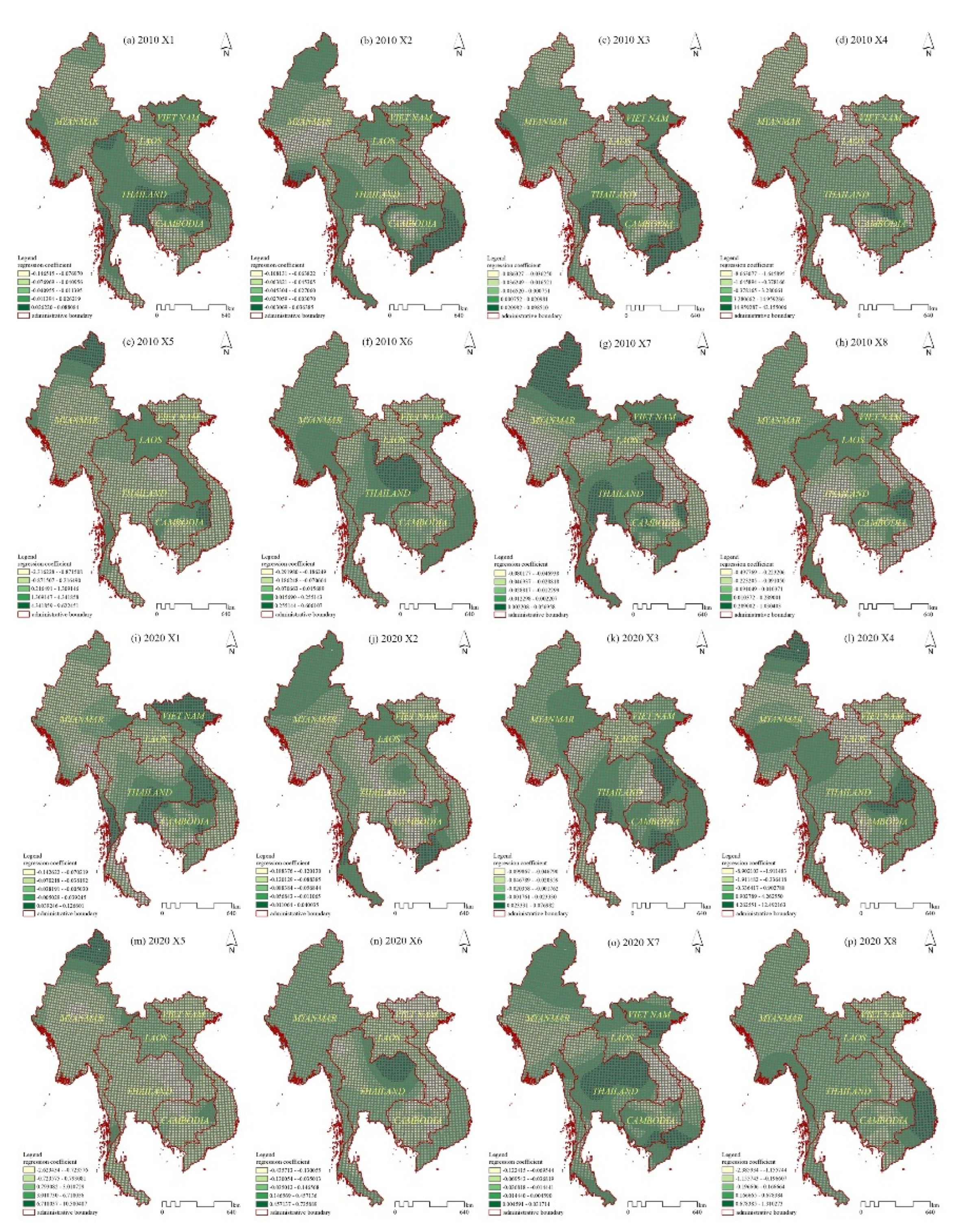
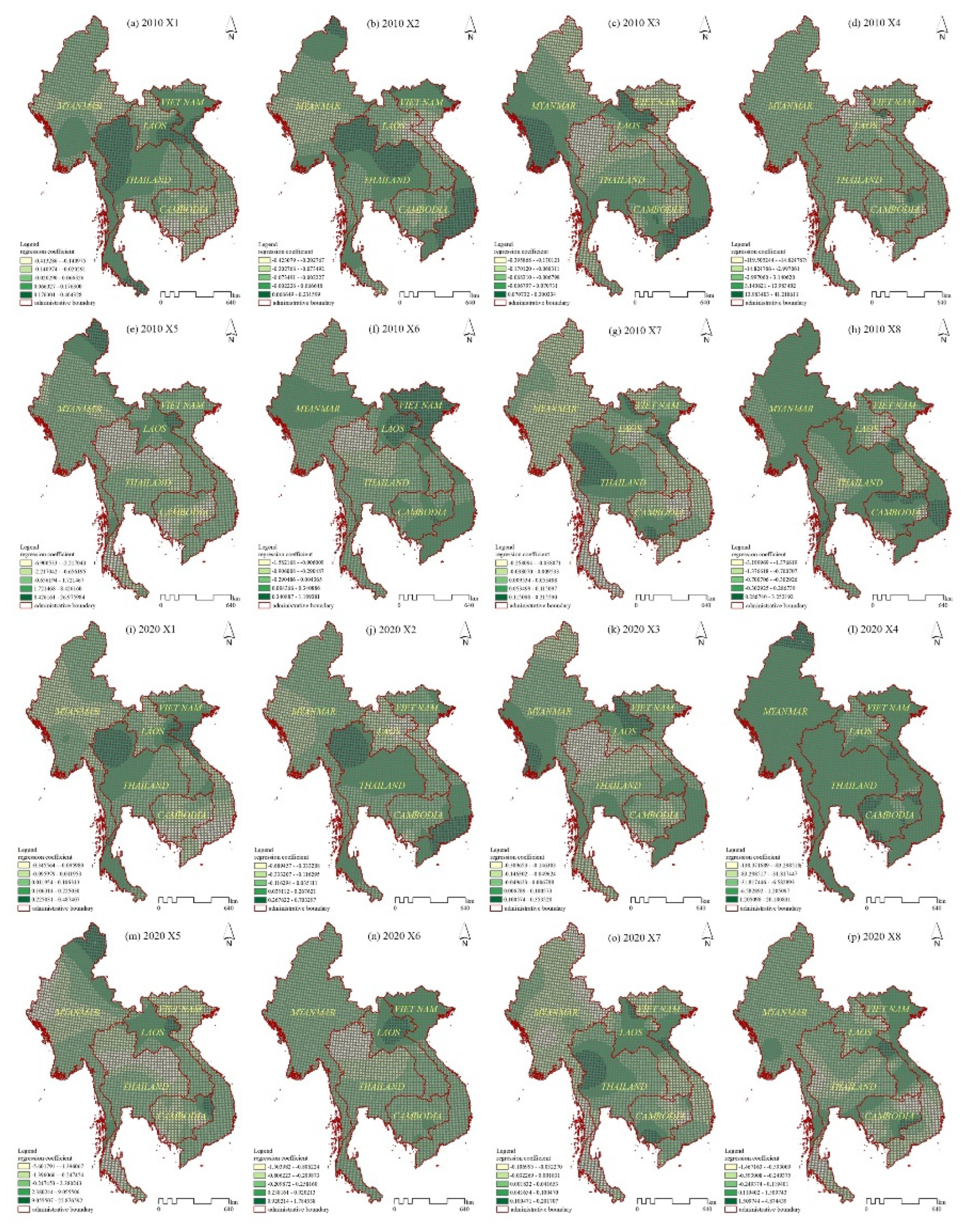
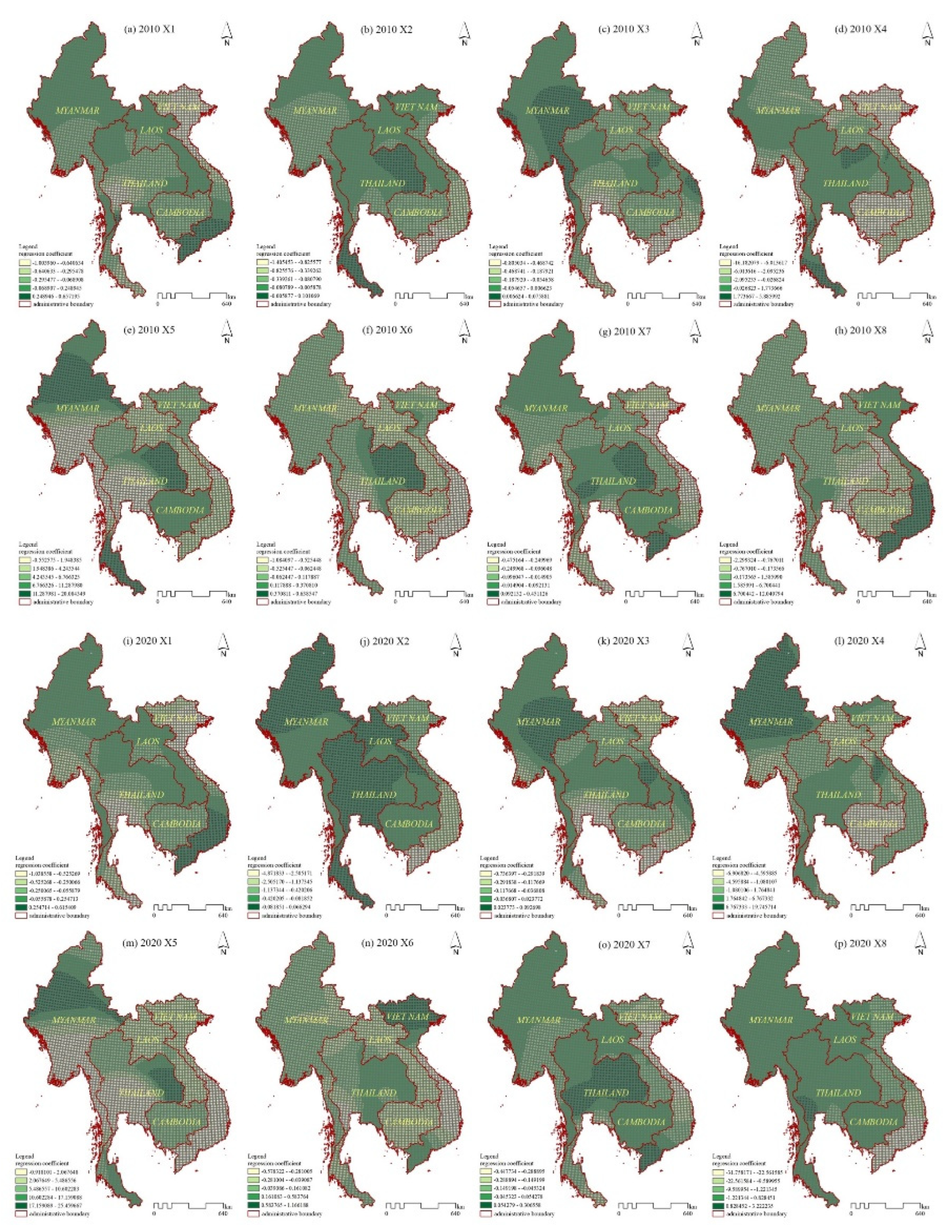
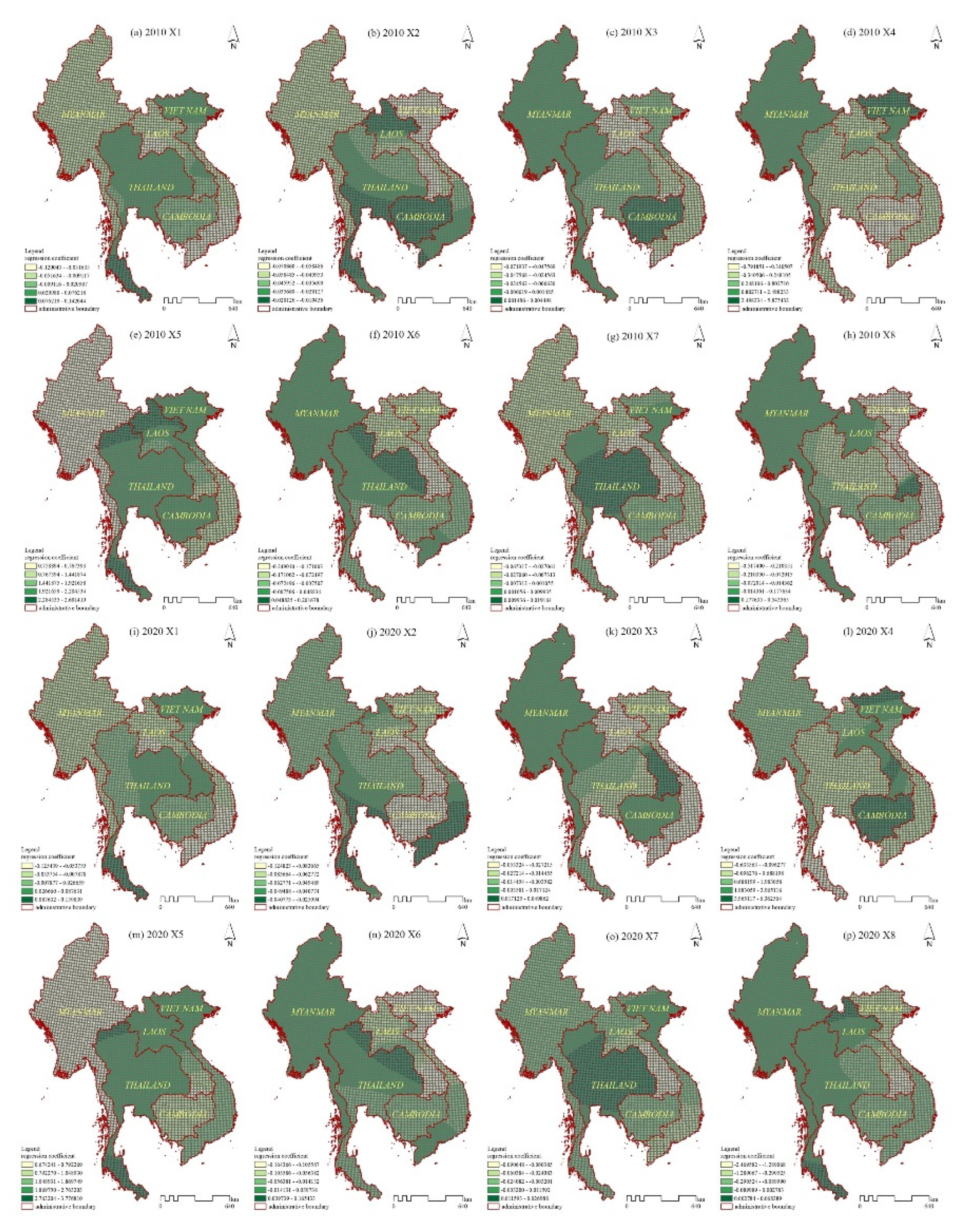
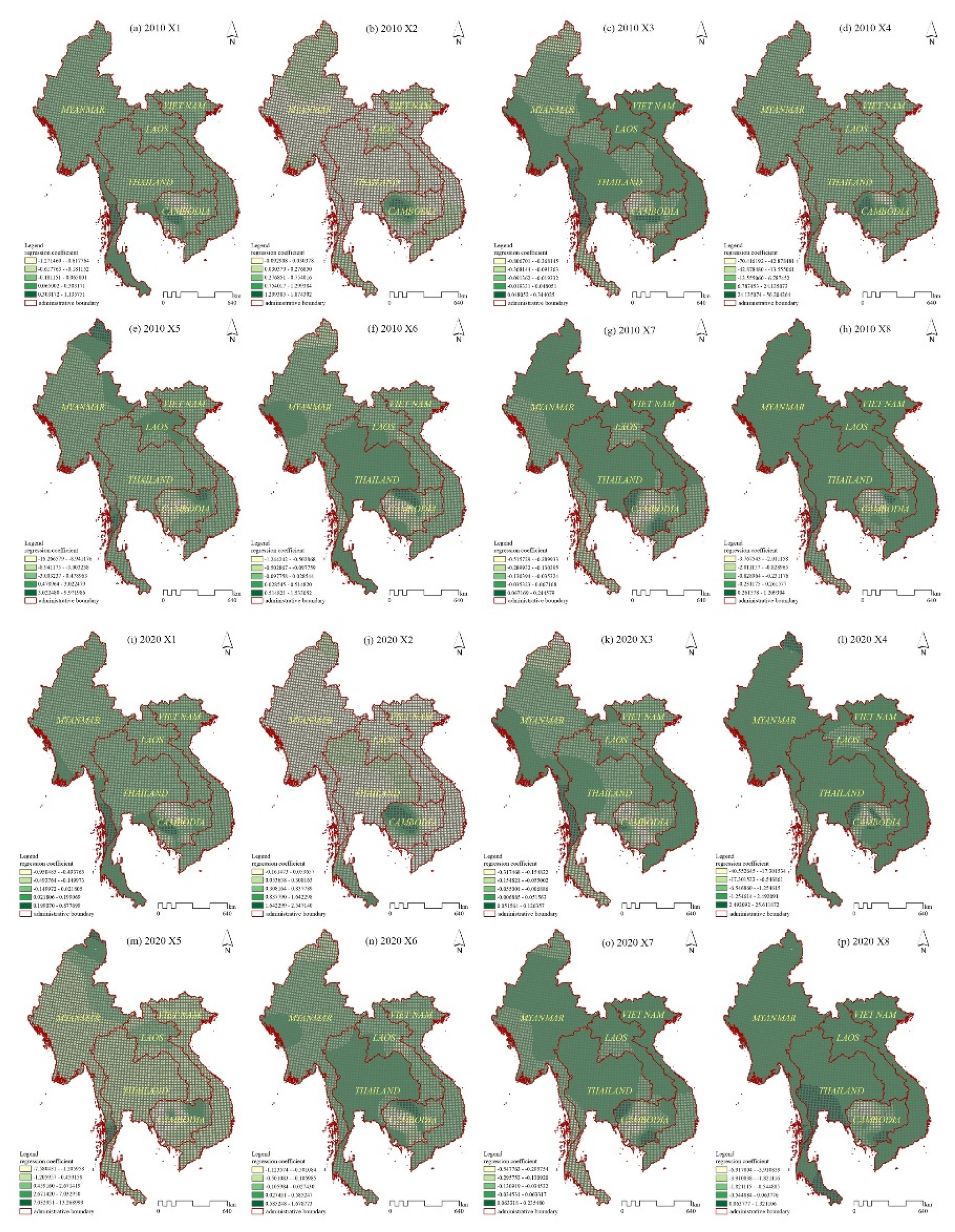
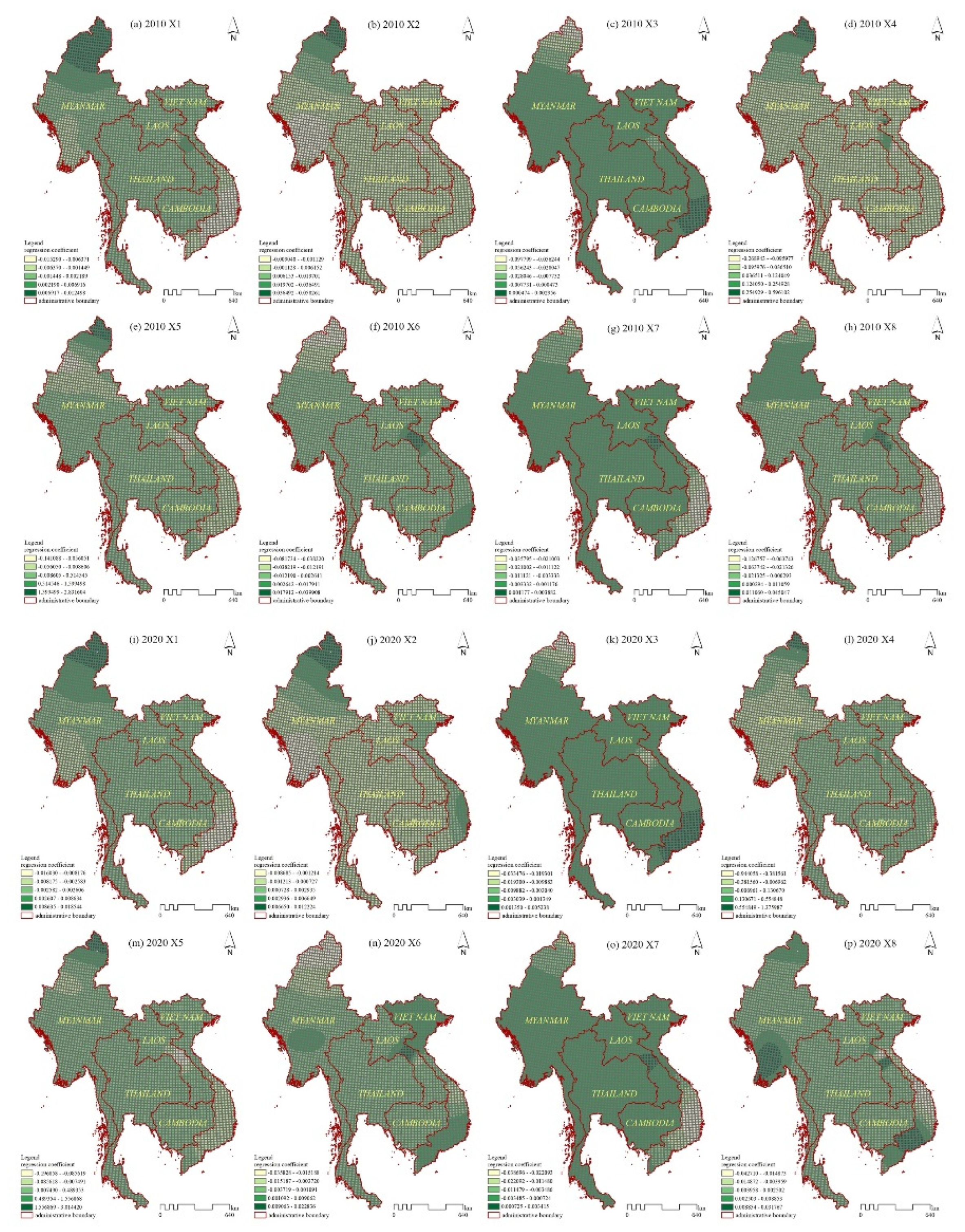
References
- Perz, S.G.; Qiu, Y.; Xia, Y.; Southworth, J.; Sun, J.; Marsik, M.; Rocha, K.; Passos, V.; Rojas, D.; Alarcón, G.; et al. Trans-Boundary Infrastructure and Land Cover Change: Highway Paving and Community-Level Deforestation in a Tri-National Frontier in the Amazon. Land Use Policy 2013, 34, 27–41. [Google Scholar] [CrossRef]
- Li, Q.; Lu, R.; Li, G.; et al. Research progress on regional land-use change along national border and it's interactive relationship with frontier trade development. China Land Science, 2015,29(8):16-23. [CrossRef]
- Feng, J.; Li, P.; Xiao, C.; et al. Border prone characteristics of agricultural expansion and intensification in the borders of Thailand and its neighboring countries (Cambodia, Laos and Myanmar) under the context of geo-economy. Journal of Geo-information Science,2021, 23(3):479-491. [CrossRef]
- Xiao, C.; Rao, D.; Liu, Y.; et al. Construction land expansion in the MohanBoten port area between China and Laos in the geoeconomic cooperation context. Journal of Geoinformation Science, 2019,21(10):1576- 1585. [CrossRef]
- Zou, L.; Liu, Y.; Yang, J.; Yang, S.; Wang, Y. ; Cao zhi; Hu, X. Quantitative Identification and Spatial Analysis of Land Use Ecological-Production-Living Functions in Rural Areas on China’s Southeast Coast. Habitat International 2020, 100, 102182. [Google Scholar] [CrossRef]
- Xie, X.; Li, X.; Fan, H.; He, W. Spatial Analysis of Production-Living-Ecological Functions and Zoning Method under Symbiosis Theory of Henan, China. Environ Sci Pollut Res Int 2021, 28, 69093–69110. [Google Scholar] [CrossRef] [PubMed]
- Liu, C.; Xu, Y.; Liu, Y.; Sun, P.; Huang, A.; Zhou, J. Research on Land Use Functions Classification and Evaluation System Based on System Theory. Beijing Daxue Xuebao (Ziran Kexue Ban)/Acta Scientiarum Naturalium Universitatis Pekinensis 2018, 54, 181–188. [Google Scholar] [CrossRef]
- Du, W.; Wang, Y.; Qian, D.; Lyu, X. Process and Eco-Environment Impact of Land Use Function Transition under the Perspective of “Production-Living-Ecological” Spaces-Case of Haikou City, China. Int. J. Environ. Res. Public Health 2022, 19, 16902. [Google Scholar] [CrossRef]
- Wang, J.; Sun, Q.; Zou, L. Spatial-Temporal Evolution and Driving Mechanism of Rural Production-Living-Ecological Space in Pingtan Islands, China. Habitat Int. 2023, 137, 102833. [Google Scholar] [CrossRef]
- Shi, Z.; Deng, W.; Zhang, S. Spatio-Temporal Pattern Changes of Land Space in Hengduan Mountains during 1990–2015. J. Geogr. Sci. 2018, 28, 529–542. [Google Scholar] [CrossRef]
- Hongjun, S.; Ge, S.; Hongmei, Z. Identification of production-living-ecological space at Keshan County level in main grain producing areas in northern Songnen Plain, China. dbkxxb 2020, 36, 264–271. [Google Scholar] [CrossRef]
- Cui, X.; Xu, N.; Chen, W.; Wang, G.; Liang, J.; Pan, S.; Duan, B. Spatio-Temporal Variation and Influencing Factors of the Coupling Coordination Degree of Production-Living-Ecological Space in China. Int. J. Environ. Res. Public Health 2022, 19, 10370. [Google Scholar] [CrossRef] [PubMed]
- Xu, N.; Chen, W.; Pan, S.; Liang, J.; Bian, J. Evolution Characteristics and Formation Mechanism of Production-Living-Ecological Space in China: Perspective of Main Function Zones. Int J Environ Res Public Health 2022, 19, 9910. [Google Scholar] [CrossRef]
- Wang, Q.; Wang, H. Dynamic Simulation and Conflict Identification Analysis of Production–Living–Ecological Space in Wuhan, Central China. Integr Envir Assess & Manag 2022, 18, 1578–1596. [Google Scholar] [CrossRef]
- Zhang, R.; Li, S.; Wei, B.; Zhou, X. Characterizing Production–Living–Ecological Space Evolution and Its Driving Factors: A Case Study of the Chaohu Lake Basin in China from 2000 to 2020. IJGI 2022, 11, 447. [Google Scholar] [CrossRef]
- Wu, S.; Wang, Z.; Du, Z.; Huang, B.; Zhang, F.; Liu, R. Geographically and Temporally Neural Network Weighted Regression for Modeling Spatiotemporal Non-Stationary Relationships. International Journal of Geographical Information Science 2021, 35, 582–608. [Google Scholar] [CrossRef]
- Liu, C.; Xu, Y.; Lu, X.; Han, J. Trade-Offs and Driving Forces of Land Use Functions in Ecologically Fragile Areas of Northern Hebei Province: Spatiotemporal Analysis. Land Use Policy 2021, 104, 105387. [Google Scholar] [CrossRef]
- Zhu, L.; Meng, J.; Zhu, L. Applying Geodetector to Disentangle the Contributions of Natural and Anthropogenic Factors to NDVI Variations in the Middle Reaches of the Heihe River Basin. Ecological Indicators 2020, 117, 106545. [Google Scholar] [CrossRef]
- Fan, Q.; Song, X.; Shi, Y.; Gao, R. Influencing Factors of Spatial Heterogeneity of Land Surface Temperature in Nanjing, China. IEEE J. Sel. Top. Appl. Earth Observations Remote Sensing 2021, 14, 8341–8349. [Google Scholar] [CrossRef]
- Zhao, J.; Zhao, Y. Synergy/Trade-Offs and Differential Optimization of Production, Living, and Ecological Functions in the Yangtze River Economic Belt, China. Ecological Indicators 2023, 147, 109925. [Google Scholar] [CrossRef]
- Fotheringham, A.S.; Yang, W.; Kang, W. Multiscale Geographically Weighted Regression (MGWR). Annals of the American Association of Geographers 2017, 107, 1247–1265. [Google Scholar] [CrossRef]
- Wei, C.; Liu, C.; Gui, F. Geographically Weight Seemingly Unrelated Regression (GWSUR): A Method for Exploring Spatio-Temporal Heterogeneity. Applied Economics 2017, 49, 4189–4195. [Google Scholar] [CrossRef]
- Huang, B.; Wu, B.; Barry, M. Geographically and Temporally Weighted Regression for Modeling Spatio-Temporal Variation in House Prices. Int. J. Geogr. Inf. Sci. 2010, 24, 383–401. [Google Scholar] [CrossRef]
- Jiang, F.; Chen, B.; Li, P.; Jiang, J.; Zhang, Q.; Wang, J.; Deng, J. Spatio-Temporal Evolution and Influencing Factors of Synergizing the Reduction of Pollution and Carbon Emissions - Utilizing Multi-Source Remote Sensing Data and GTWR Model. Environmental Research 2023, 229, 115775. [Google Scholar] [CrossRef] [PubMed]
- Qiao, M.; Huang, B. COVID-19 Spread Prediction Using Socio-Demographic and Mobility-Related Data. Cities 2023, 138, 104360. [Google Scholar] [CrossRef]
- Kelly, P.L. Escalation of Regional Conflict: Testing the Shatterbelt Concept. Political Geography Quarterly 1986, 5, 161–180. [Google Scholar] [CrossRef]
- Wu, Z. Classical Geopolitics, Realism and the Balance of Power Theory. J. Strateg. Stud. 2018, 41, 786–823. [Google Scholar] [CrossRef]
- Chen, A.L.Q. The Belt and Road Initiative as a Variegated Agglomeration of Multi-Scalar State Spatial Strategies. Territ. Polit. Gov. 2023, 11, 478–501. [Google Scholar] [CrossRef]
- Chen, S.; Li, Y. Study on the traffic network system of international subregional cooperation of the connective part of the China, Laos, Burma and Thailand. Economic Geography, 2000(6): 84-87+96. [CrossRef]
- Zhang, L.; Wu, Y.; Li, J.; et al. Analysis of land use and landscape pattern change in Myanmar section of the Golden Quadrangle Region in the border of China, Myanmar, Thailand and Laos. World Regional Studies, 2018,27(4):21-33. [CrossRef]
- Liu, X.; Feng, Z.; Jiang, L. Progress of land use and land cover change research in the "Golden Four Corners" region of China, Laos, Myanmar and Thailand. Progress in Geoscience, 2013, 32(2): 191-202. [CrossRef]
- Yoshida, A.; Chanhda, H.; Ye, Y.-M.; Liang, Y.-R. Ecosystem Service Values and Land Use Change in the Opium Poppy Cultivation Region in Northern Part of Lao PDR. Acta Ecologica Sinica 2010, 30, 56–61. [Google Scholar] [CrossRef]
- Thongmanivong, S.; Fujita, Y. Recent Land Use and Livelihood Transitions in Northern Laos. mred 2006, 26, 237–244. [Google Scholar] [CrossRef]
- Tian, Y.; Wu, B.; Zhang, L.; Li, Q.; Jia, K.; Wen, M. Opium Poppy Monitoring with Remote Sensing in North Myanmar. International Journal of Drug Policy 2011, 22, 278–284. [Google Scholar] [CrossRef]
- Yang, X. Analysis of the "Four Corners" Economic Cooperation Program among China, Lao People's Democratic Republic, Myanmar and Thailand. Southeast Asian Studies. [CrossRef]
- Li, H.; Guan, L.; Chen, J. Study on Remote Sensing Monitoring of Land Use Based on Road Net Buffer. In Proceedings of the PIAGENG 2013: Intelligent Information, Control, and Communication Technology for Agricultural Engineering; SPIE, March 19 2013; Vol. 8762; pp. 262–267. [Google Scholar] [CrossRef]
- Li, Q.; Su, Y.; Feng, Z.; et al. Study on production-living-ecological space function coupling coordination in Fen river basin. SSWC, 2021, 19(5): 115-125. [CrossRef]
- Zheng, F.; Xiao, C.; Feng, Z. Impact of Armed Conflict on Land Use and Land Cover Changes in Global Border Areas. Land Degrad Dev 2023, 34, 873–884. [Google Scholar] [CrossRef]
- Pettit, L. Conditioning Diagnostics: Collinearity and Weak Data in Regression. Journal of the Royal Statistical Society: Series C (Applied Statistics) 1992, 41, 601–601. [Google Scholar] [CrossRef]
- Naes, T.; Mevik, B.-H. Understanding the Collinearity Problem in Regression and Discriminant Analysis: COLLINEARITY PROBLEM IN REGRESSION AND DISCRIMINANT ANALYSIS. J. Chemometrics 2001, 15, 413–426. [Google Scholar] [CrossRef]
- Ding, Y.; Zhang, J.; Liu, Y.; Lu, C.; Wang, S.; Qin, J.; Ding, S. Spatial distribution characteristics and influencing factors of soil organic carbon in Yihe River Basin based on GWR model. Acta Ecologica Sinica,2021,41(12): 4876-4885. [CrossRef]
- Zhang, S.; Shao, H.; Li, X.; Xian, W.; Shao, Q.; Yin, Z.; Lai, F.; Qi, J. Spatiotemporal Dynamics of Ecological Security Pattern of Urban Agglomerations in Yangtze River Delta Based on LUCC Simulation. Remote Sens. 2022, 14, 296. [Google Scholar] [CrossRef]
- Liu, C.; Xu, R.; Xu, K.; Lin, Y.; Cao, Y. Carbon Emission Effects of Land Use in Chaobai River Region of Beijing–Tianjin–Hebei, China. Land 2023, 12, 1168. [Google Scholar] [CrossRef]
- Yang, L.; Liu, F. A study on the evolution of the spatial pattern of tri-generation in central Yunnan urban agglomeration based on LUCC. Shanghai Land Resources,2023,44(02):28-35. [CrossRef]
- Chen, Z.; Li, X.; Xia, X. Temporal-Spatial Pattern and Driving Factors of Cultivated Land Use Transition at Country Level in Shaanxi Province, China. Environ Monit Assess 2022, 194, 365. [Google Scholar] [CrossRef]
- Luo, Y. ; From the GMS to the Lancang-Mekong Cooperation: competing international institutions on the Indochina Peninsula. Diplomatic Review (Journal of Foreign Affairs College),2018,35(06):119-156. [CrossRef]
- Mather, A.S. The Forest Transition. Area 1992, 24, 367–379. [Google Scholar] [CrossRef]
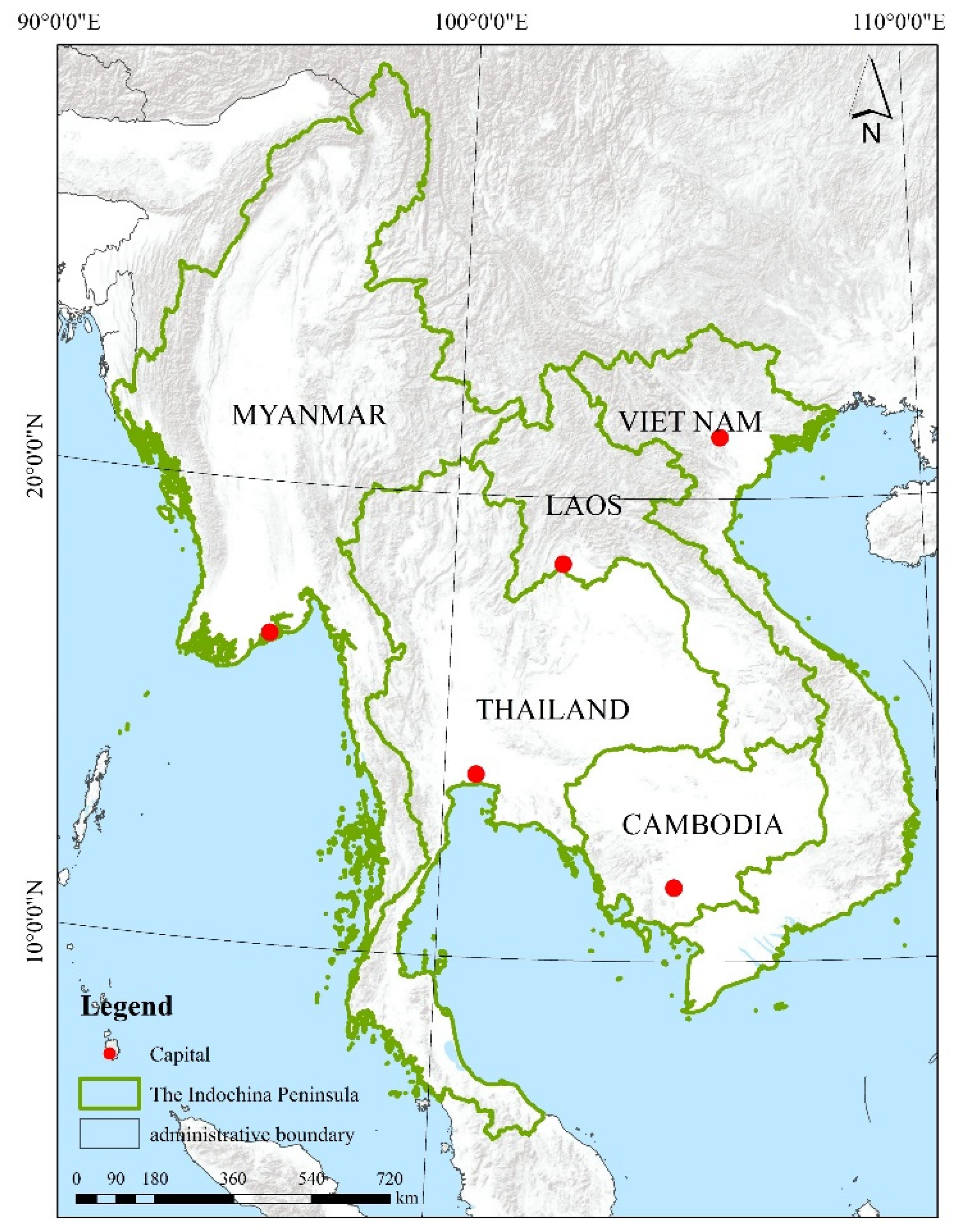
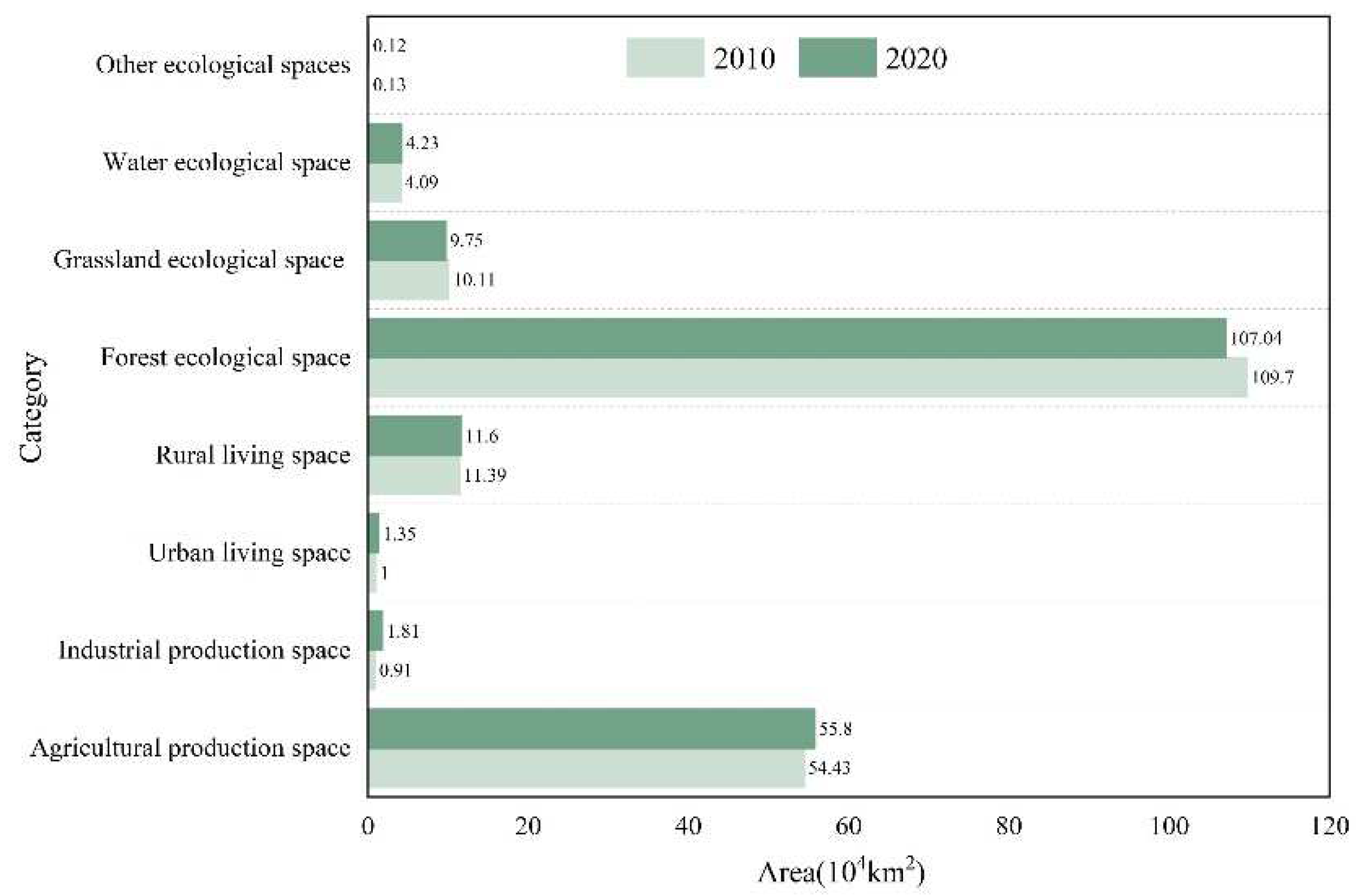
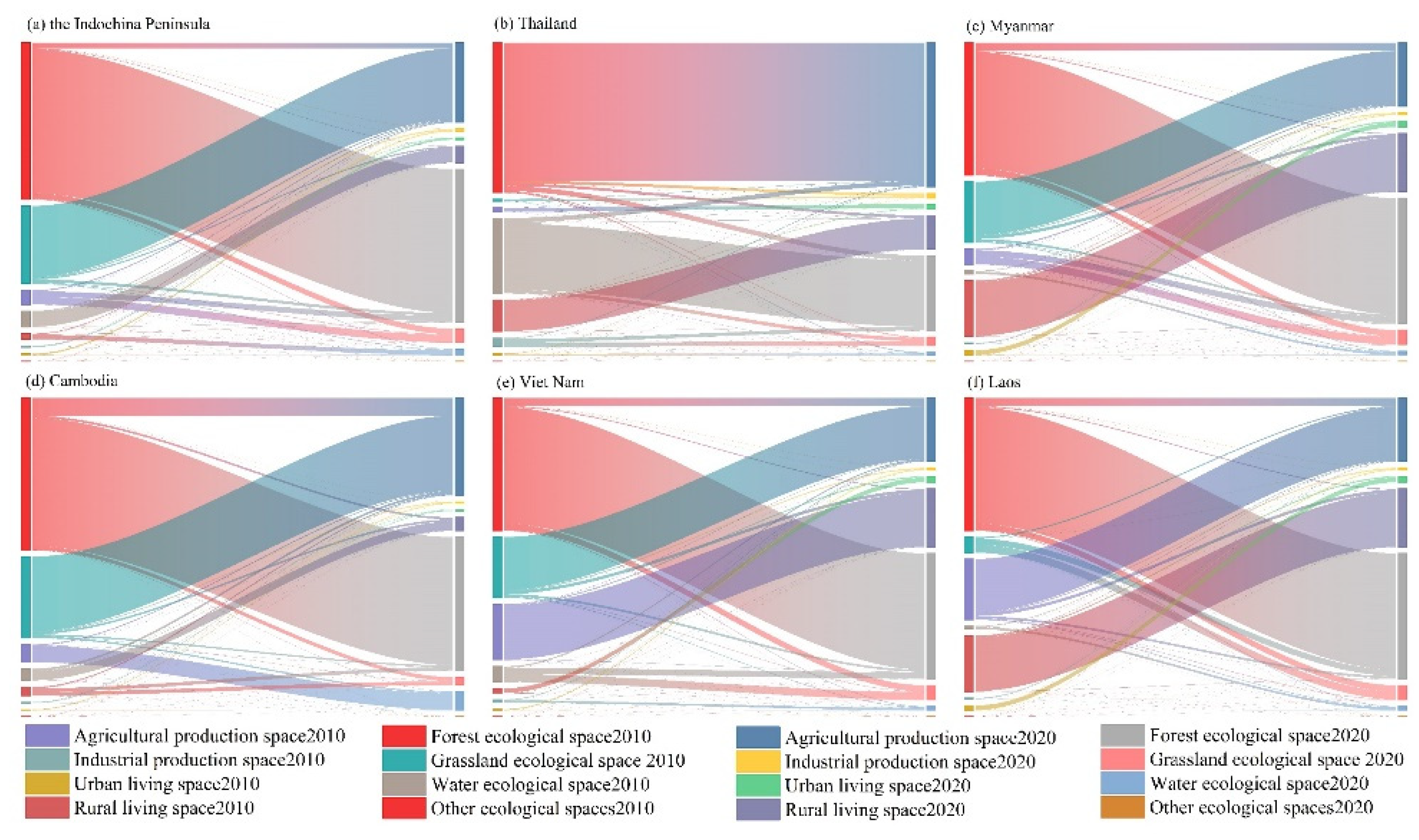
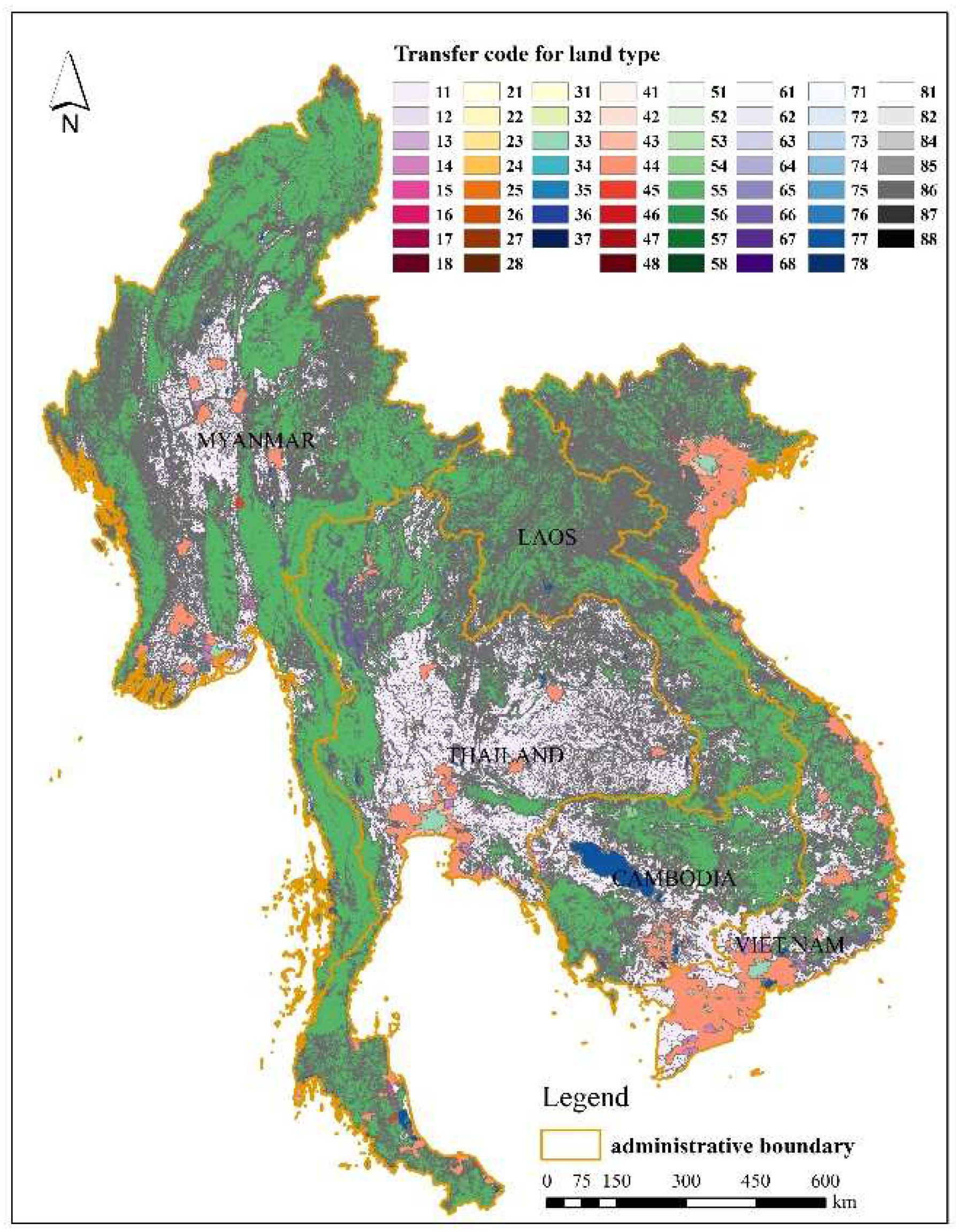
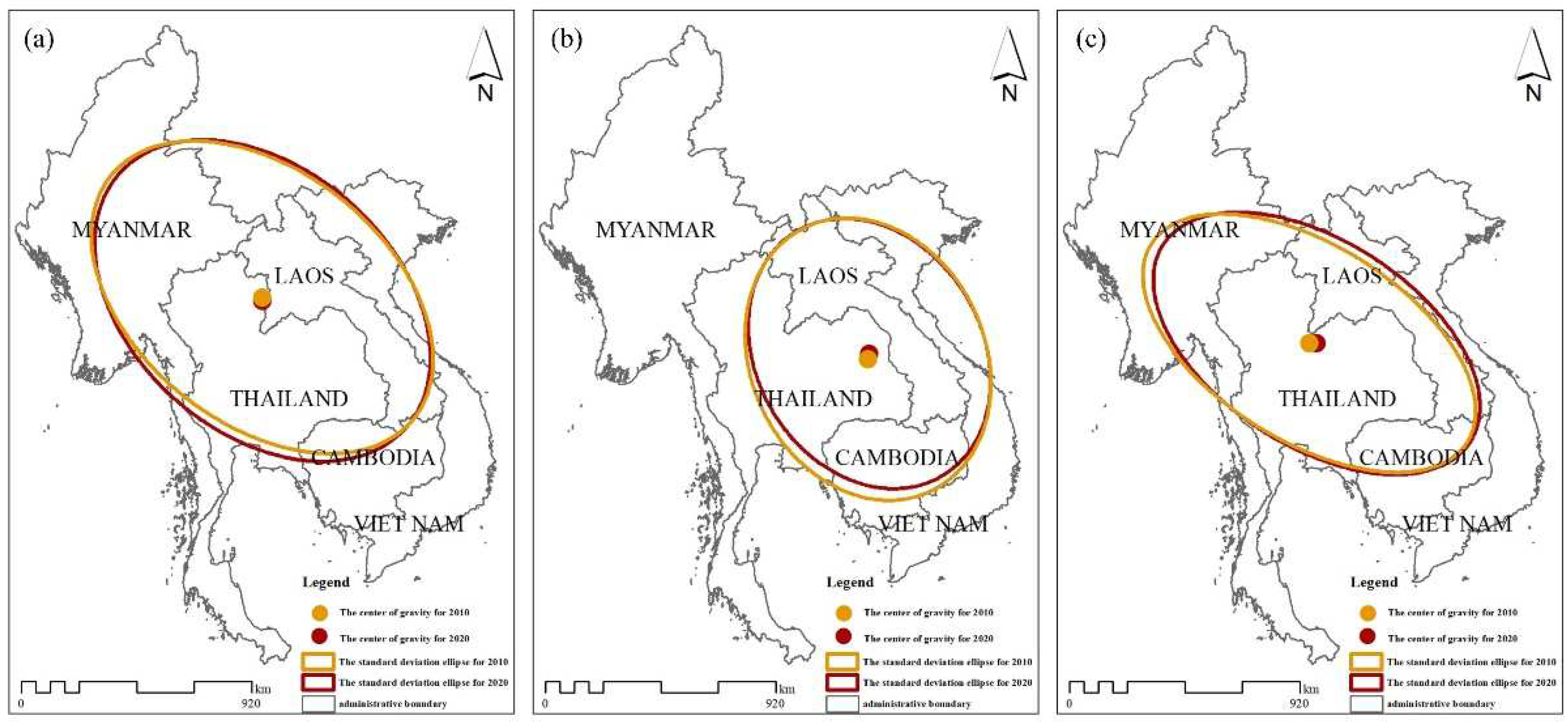
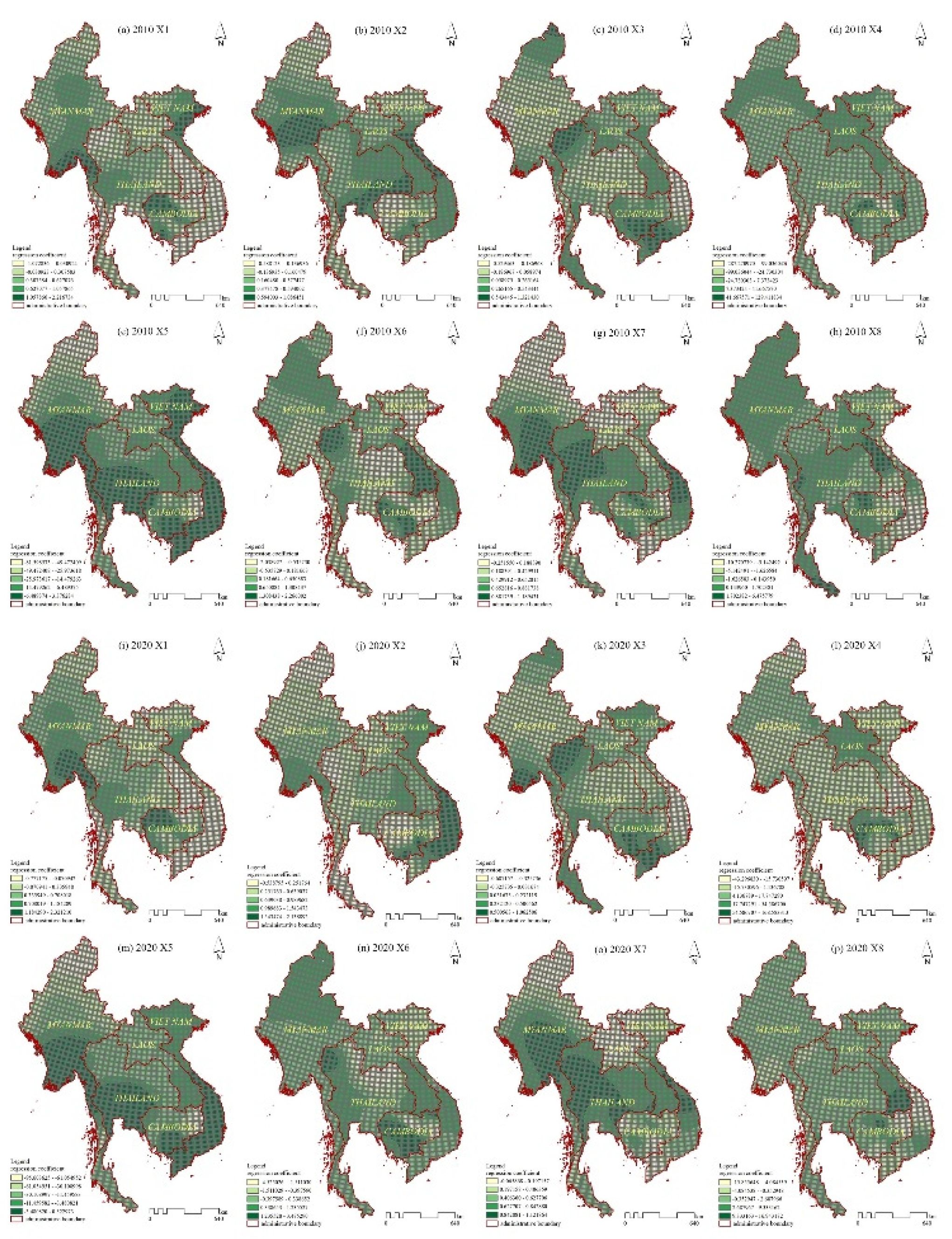
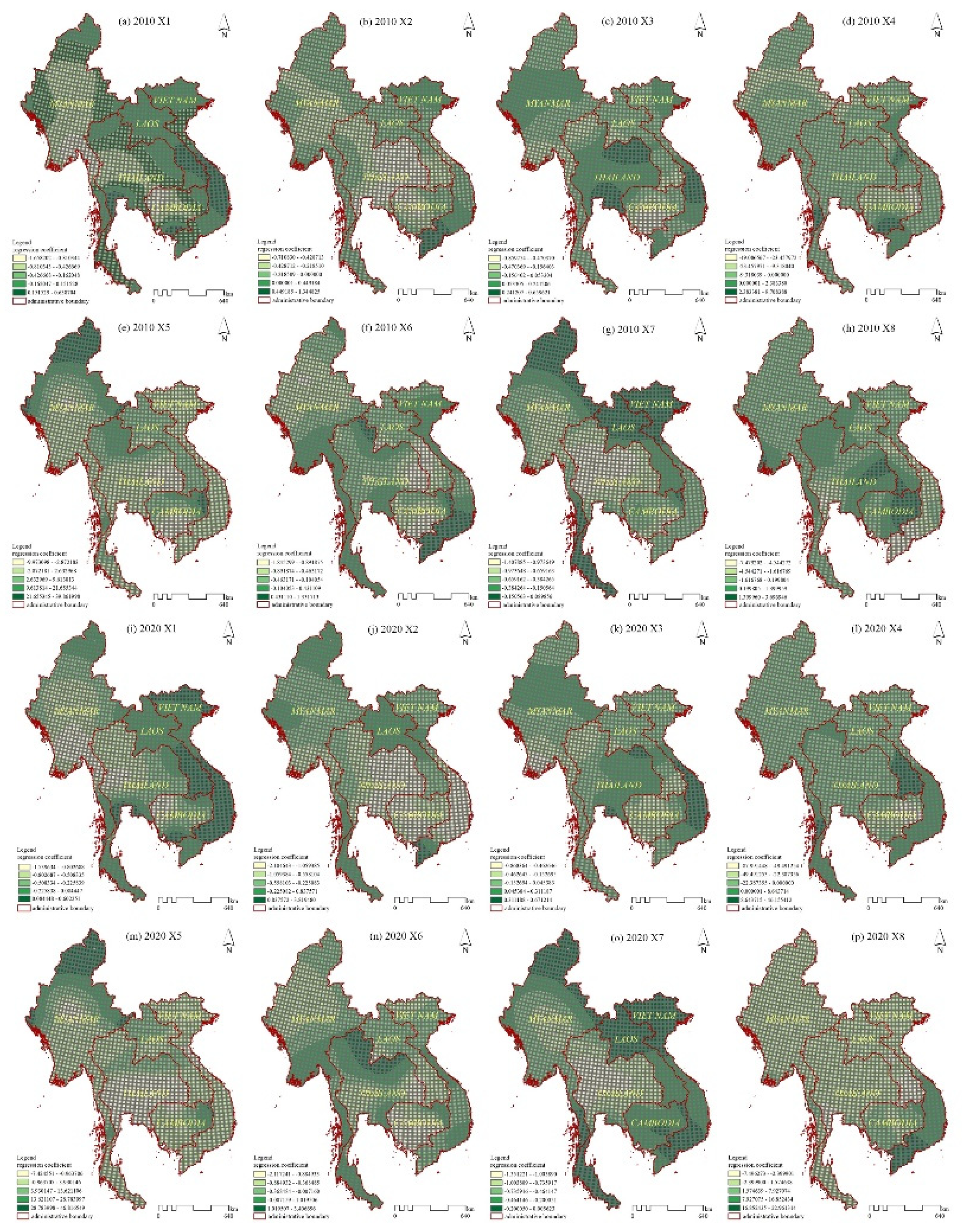
| Primary category | Secondary category | Data source |
|---|---|---|
| The production space | 1—Agricultural production space; | GlobeLand30: cropland |
| 2—Industrial production space; | GlobeLand30: artificial surface (excluding the range of living space defined by SEDAC) |
|
| The living space | 3—Urban living space; | SEDAC: the population density is greater than 1500/km2 |
| 4—Rural living space; | SEDAC: the population density is 300–1500 /km2 |
|
| The ecological space | 5—Forest ecological space; | GlobeLand30: forest, bush |
| 6—Grassland ecological space; | GlobeLand30: grass | |
| 7—Water ecological space; | GlobeLand30: wetlands, water, glaciers and permanent snow cover |
|
| 8—Other ecological spaces | GlobeLand30: tundra, bare land |
| Datatypes | parameter | factor | Introduction to data | Data source |
|---|---|---|---|---|
| Humanistic location | X1 | Distance to railway | Indicates the distance from the centre of each pixel to the nearest railway line | https://www.openstreetmap.org https://www.naturalearthdata.com/ |
| X2 | Distance to road | Indicates the distance from the centre of each pixel to the nearest road | Socioeconomic Data and Applications Center | SEDAC (columbia.edu) https://www.openstreetmap.org |
|
| X3 | Distance to river | Indicates the distance from the centre of each pixel to the nearest river | https://www.openstreetmap.org | |
| social economy | X4 | Night Lights | Indicates the nighttime light value within each pixel | VIIRS Nighttime Light (mines.edu) geodata.cn |
| X5 | population density | denotes the value of population density within each pixel | https://sedac.ciesin.columbia.edu/ | |
| natural environment | X6 | precipitation | Indicates the value of rainfall within each pixel | Climatic Research Unit - Groups and Centres (uea.ac.uk) |
| X7 | Normalized Difference Vegetation Index(NDVI) | Indicates the NDVI value within each pixel | https://ladsweb.modaps.eosdis.nasa.gov/ | |
| geopolitics | X8 | Armed conflict events | Indicates the number of deaths from armed conflict in each pixel. | ACLED | Bringing Clarity to Crisis (acleddata.com) |
| VIF | X1 | X2 | X3 | X4 | X5 | X6 | X7 | X8 |
|---|---|---|---|---|---|---|---|---|
| 2010 | 1.125 | 1.068 | 1.069 | 1.283 | 1.326 | 1.061 | 1.104 | 1.035 |
| 2020 | 1.14 | 1.121 | 1.068 | 1.065 | 1.088 | 1.072 | 1.077 | 1.04 |
| 2010-2020 | 1.131 | 1.077 | 1.063 | 1.166 | 1.196 | 1.06 | 1.085 | 1.038 |
| id | category | Laos | Cambodia | Myanmar | Thailand | Viet Nam | the Indochina Peninsula |
|---|---|---|---|---|---|---|---|
| 1 | Agricultural production space | 0.80% | 1.97% | -0.14% | 0.01% | 0.47% | 0.25% |
| 2 | Industrial production space | 63.19% | 7.56% | 5.50% | 13.69% | 10.85% | 9.84% |
| 3 | Urban living space | 2.53% | 6.63% | -0.42% | 7.45% | 2.12% | 3.44% |
| 4 | Rural living space | 3.14% | 1.12% | 1.64% | -1.59% | 0.42% | 0.18% |
| 5 | Forest ecological space | -0.18% | -1.23% | -0.05% | 0.00% | -0.55% | -0.24% |
| 6 | Grassland ecological space | 0.10% | -0.70% | -0.02% | -1.05% | -0.58% | -0.36% |
| 7 | Water ecological space | 1.96% | 0.42% | 0.37% | -0.51% | 1.57% | 0.34% |
| 8 | Other ecological spaces | 1.40% | -2.62% | 422.08% | 8.21% | -0.42% | |
| comprehensive land-use dynamic index | 0.14% | 0.71% | 0.07% | 0.13% | 0.30% | 0.16% | |
| year | category | X1 | X2 | X3 | X4 | X5 | X6 | X7 | X8 |
|---|---|---|---|---|---|---|---|---|---|
| 2010 | Agricultural production space | -0.264 | -0.169 | 0.011 | -3.810 | 4.692 | -0.250 | -0.478 | -0.286 |
| Industrial production space | -0.021 | -0.034 | -0.010 | 0.038 | 0.617 | -0.002 | -0.018 | -0.063 | |
| Urban living space | -0.127 | -0.119 | -0.092 | -1.857 | 6.327 | -0.079 | -0.038 | 1.049 | |
| Rural living space | -0.001 | -0.043 | -0.012 | 0.626 | 1.574 | -0.023 | -0.007 | -0.075 | |
| Forest ecological space | 0.384 | 0.314 | 0.158 | 3.360 | -13.91 | 0.344 | 0.551 | -0.203 | |
| Grassland ecological space | 0.045 | -0.012 | -0.033 | -0.710 | 0.056 | -0.033 | 0.019 | -0.280 | |
| Water ecological space | -0.002 | 0.060 | -0.028 | 0.539 | -0.142 | 0.000 | -0.044 | -0.121 | |
| Other ecological spaces | 0.000 | 0.002 | -0.003 | 0.016 | 0.043 | -0.002 | -0.002 | -0.005 | |
| 2020 | Agricultural production space | -0.301 | -0.551 | -0.013 | -6.364 | 5.143 | -0.191 | -0.448 | 1.449 |
| Industrial production space | -0.024 | -0.081 | -0.008 | 0.346 | 0.623 | -0.003 | -0.021 | -0.044 | |
| Urban living space | -0.106 | -0.291 | -0.061 | 2.112 | 6.758 | 0.041 | -0.038 | -2.406 | |
| Rural living space | -0.001 | -0.059 | -0.007 | 1.461 | 1.575 | -0.021 | -0.009 | -0.151 | |
| Forest ecological space | 0.409 | 0.726 | 0.126 | 4.707 | -16.17 | 0.161 | 0.561 | 0.653 | |
| Grassland ecological space | 0.056 | -0.002 | -0.023 | -1.960 | 0.604 | -0.006 | 0.012 | -0.095 | |
| Water ecological space | -0.009 | 0.112 | -0.021 | -0.546 | 0.269 | -0.003 | -0.043 | -0.152 | |
| Other ecological spaces | 0.000 | 0.001 | -0.001 | 0.010 | 0.045 | -0.001 | -0.002 | 0.001 |
Disclaimer/Publisher’s Note: The statements, opinions and data contained in all publications are solely those of the individual author(s) and contributor(s) and not of MDPI and/or the editor(s). MDPI and/or the editor(s) disclaim responsibility for any injury to people or property resulting from any ideas, methods, instructions or products referred to in the content. |
© 2023 by the authors. Licensee MDPI, Basel, Switzerland. This article is an open access article distributed under the terms and conditions of the Creative Commons Attribution (CC BY) license (https://creativecommons.org/licenses/by/4.0/).





